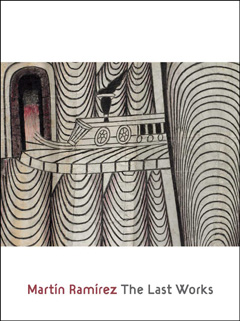Martin Ramirez: The Last Works, by Brooke Davis Anderson, Richard Rodriguez and Wayne Thiebaud. Pomegranate, 160 pages, 136 illustrations, 2008. ISBN 978-0-7649-4695-0

The ratio of text to photos in this second major volume dedicated to Martin Ramirez is low, and that comes as a relief to someone who feels compelled to read books front to back, even when not reviewing them.
The catalog published last year in conjunction with Ramirez’s epochal one-man at the American Folk Art Museum had many virtues. Contributions by Anderson and by Victor and Kristin Espinosa supplied essential (and in the Espinosas’ case ground-breaking) background and perspective. But several of the more than half-dozen essays felt like heft more than light.
There are only 23 pages of text in this new book, including footnotes. Introductory sections include a foreword from the artist’s descendants as well as an acknowledgements page whose plethora of thanks to lawyers presumably reflects the family’s assertion of its rights to the oeuvre. A brief essay by Wayne Thiebaud, who encountered Ramirez in the 1950s, provides a rare first-hand description of his working methods.
These late drawings surfaced after wildly favorable publicity around the original AFAM show brought Ramirez to prominence outside the outsider art world. Their discovery represented more than just good fortune for the family of Doctor Max Dunievitz, who had once supplied Ramirez with art materials. The material was produced later in the artist’s life, between 1960 and his death in 1963. His reputation had been based on earlier drawings, so at minimum this is the first chance to see on a large scale how Ramirez’s talent evolved.
If these pictures were more of the same, their discovery would still have added substantially to our knowledge of Ramirez. But they demonstrate definite, and interesting, artistic development from the earlier work. There seems to be a notable tendency toward abstraction and increased use of color (though the bright colors may reflect better preservation in pictures that have been stored for decades rather than hanging on walls).
The artist’s familiar subjects evolved along with the work’s formal qualities. Repetition and patterning are even more intense in his treatment of trains and tunnels. In several horse-and-rider pictures shown here, a trumpet, sometimes grotesquely oversized, replaces guns and bandoliers. In others, horses and riders are mixed up with tunnels and trains. In one series the horse and rider are set on a large, isolated platform amidst a fantastical agglomeration of arches and tunnel entrances.
Some of the most intriguing pictures are the sheets filled with nothing but arches, sometimes dozens of them, with no trains or any other subject — in one case 234 inches of arches. This monumental near-abstraction is unmistakably Ramirez, but it also represents an astounding evolution from the earlier work that made his reputation, work that is more straight-forwardly representational if also surrealistic.
This book also includes three spooky pictures showing a man at a table drawing with a quill pen. In all three there are two rows of arches along the bottom of the drawing, Characteristic mountainous patterns converge along the two outer edges of the top. But what is most striking are the blank eyes that would be staring out at the viewer if there were anything in them to see with.
Altogether, there is lots of fodder for interpretation in these pictures, but the editors and authors show an admirable discipline in not over-reaching in their assessments. The pictures themselves are richly presented, large and sharply reproduced, with a number of foldouts to accommodate extra-wide images.
A version of this review originally appeared in Intuit’s Outsider magazine.

hi, my site is about anonymous art (since 2004); has to do with your idea’s. if it is ok with you: a link to your site ans a quote is now on my site. thanks, mark (he netherlands)
Bill,
Thanks for this article. I learned about Ramirez a couple of years back, and I made my first-ever trek to Milwaukee to see an exhibition of his work. I cannot explain why, but I appreciate his artistry, which I find oddly compelling. We all strive to make order of our lives; I’m fascinated by the journeys others take and how they share their stories.
Cheers,
Brian
who counts arches?